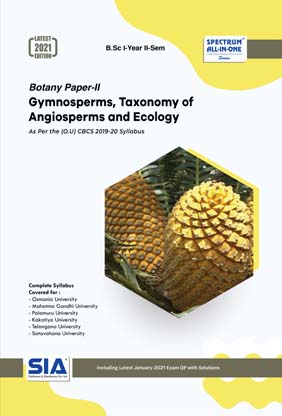

Note: Please check your Spam or Junk folder, in case you didn't receive the email with verification code.
SYLLABUS
UNIT-I
1. Gymnosperms: General characters, structure, reproduction and classification (Sporne’s). Distribution and economic importance of gymnosperms. 2. Morphology of vegetative and reproductive parts, systematic position and life-cycle of Pinus and Gnetum. 3. Geological time scale introduction to palaeobotany, types of fossils and fossilization, importance of fossils.
UNIT-II
1. Introduction: Principles of plant systematics, types of classification: Artificial, natural and phylogenetic Systems of Classification: Salient features and comparative account of Bentham & Hooker and Engler & Prantl classification systems.An introduction toAngiosperm Phylogeny Group (APG). 2. Current Concepts ofAngiosperm Taxonomy: Embryology in relation to taxonomy, cytotaxonomy, chemotaxonomy and numerical taxonomy. 3. Nomenclature and Taxonomic Resources: An introduction to ICN, Shenzhen Code - a brief account. Herbarium: Concept, techniques and applications.
UNIT-III
1. Systematic study and economic importance of plants belonging to the following families: Polypetalae:Annonaceae, Capparidaceae, Rutaceae, Fabaceae (Faboideae/Papilionoideae, Caesalpiniodeae, Mimosoideae), Cucurbitaceae. 2. Gamopetalae: Apiaceae, Asteraceae, Asclepiadaceae, Lamiaceae, Monochlamydeae: Amaranthaceae, Euphorbiaceae. 3. Monocotyledons: Orchidaceae, Poaceae and Zingiberaceae.
UNIT-IV
1. Components of ecosystem, energy flow, food chain and food webs. 2. Plants and environment, ecological adaptations of plants, hydrophytes, xerophytes and mesophytes. 3. Plant succession seral stages, modification of environment, climax formation with reference to hydrosere and xerosere.
 No Preview is available for this book
No Preview is available for this book

 Get 100 instant uPoints on the purchase of Rs.100 or above for each order.
Get 100 instant uPoints on the purchase of Rs.100 or above for each order.
CategoriesArts and Science

Format PDF

TypeeBook